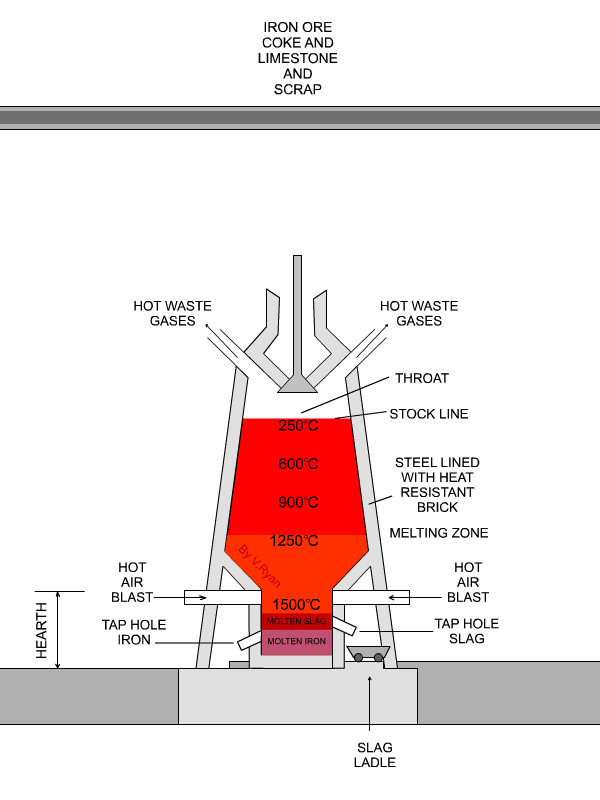A Measuring System for Burden Surface Temperature Field of Blast Furnace
It is important to measure the burden surface temperature of blast furnace (BF) since it can be used to reflect the gas flow distribution and give instruction for BF operation.
Industrial high-temperature radar and imaging technology in blast furnace burden distribution monitoring process
Abstract -A
new kind of industrial high temperature radar has been developed, which
is used for real-time monitoring of the burden surface under the harsh
environment inside blast furnace (BF) and observing the decline rate of
the burden surface. This radar technology is also used for determination
of the burden profile through multi-point arrangement of the radars.
The 26GHz frequency radar is introduced with the FMSW structure of the
hardware model, as well as the heat and dust resistant solid burden
surface algorithm with the monitoring range of 0-100 meter and the
measurement accuracy of 1%, a specially designed ceramic antenna with
the temperature range of 0-600 degree, and the drift<
0.1%/year. Six industrial high temperature radars have been installed on
the top of the BF at the industrial field, and optimized the radar
installation location through electromagnetic simulation. The real-time
image of the burden surface has been obtained by surface fitting and
digital simulation of the data from the six-point radars. The effective
application of this technology has improved significantly the
fluctuation of burden surface, the production of BF, the energy saving
and gas emission reduction.
3-Dimension Imaging System of Burden Surface with 6-radars Array in a Blast Furnace
Article in ISIJ International 52(11):2048-2054 · December 2011
Abstract - Harsh environment in Blast Furnace (BF) poses a big challenge for metallurgical industrial radar measurement of burden surface for ore and coke. The improved signal processing algorithm enhances the real-time performance. Antenna is specially designed for continuous stable signal acquirement, high temperature resistance and anti-dust ability. The experiment results illustrate that the single radar meets the accuracy requirement of solid bulk material. A new BF Burden Surface Measuring System is developed for real-time BE 3-D imaging. Distributed 6-radars array mounted on the top of 2 500 m(3) BF. A virtual 3-D imaging is achieved with a reconstruction algorithm of 6-radars array according to the actual shape of BF. 3-D imaging system with 6-radars array provides an improved technique for intelligent control of burden distribution during BE iron making process.
BLASTDAR- A Large Radar Sensor Array System for Blast Furnace Burden Surface Imaging
Zankl, D.; Schuster, S.; Feger, R.; Stelzer, A.; Scheiblhofer, S.; Schmid, C.; Ossberger, G.; Stegfellner, L.; Lengauer, G.; Feilmayr, C.; Lackner, B.; Burgler, T., "BLASTDAR – A Large Radar Sensor Array System for Blast Furnace Burden Surface Imaging," Sensors Journal, IEEE , vol.PP, no.99, pp.1,1
doi: 10.1109/JSEN.2015.2445494
Abstract: In this paper, we present a radar sensor system for real-time blast furnace burden surface imaging inside a fully operative blast furnace, called BLASTDAR, the blast furnace radar. The designed frequency-modulated continuous-wave (FMCW) radar sensor array operates in the frequency band around 77 GHz and consists of several non-uniformly spaced receive and transmit antennas, making it a multiple-input multiple-output (MIMO) radar system with large aperture. Mechanical steering is replaced by digital array processing techniques. Off-the-shelf automotive-qualified multi-channel monolithic microwave integrated circuits (MMICs) are used. By means of this configuration a virtual antenna array with 256 elements was developed that guarantees the desired angular resolution of better than 3 deg., and a range resolution of about 15 cm. Based on the single channel FMCW signal model this paper will derive a multichannel signal model in combination with a digital beamforming approach and further advanced signal processing algorithms. The implementation of a simulation tool covering the whole design process is shown. Based on these simulation results a system configuration is chosen and the obtained setup is defined and presented. A description of the manufactured cost-efficient radio frequency (RF) and baseband boards together with the housing design shows the practical implementation of the sensor. For the system calibration two different methods are listed and compared regarding their performance. Verification measurements confirm the predicted performance of the developed sensor. Several measurements inside a fully operational blast furnace demonstrate the proper long-term functionality of the system, to the best knowledge of the authors, for the first time worldwide. It is in continuous operation since about two years in blast furnace #5 of voestalpine Stahl GmbH, Linz.
keywords: {Antenna arrays;Arrays;Blast furnaces;Radar antennas;Radar imaging;Sensors;blast furnace;digital beamforming;radar imaging;sensor array;speckle effect},
URL: http://ieeexplore.ieee.org/stamp/stamp.jsp?tp=&arnumber=7123566&isnumber=4427201
USING MICROWAVE INTERFEROMETRY TO IMPROVE THE BLAST FURNACE OPERATION
Emil Nilsson - Halmstad University, Sweden; Donald Malmberg - MEFOS, Sweden
Abstract - There are many known technologies that can be used to monitor surfaces, but the most of them requires a transparent environment to be functional. In the Blast Furnace where the environment is full of dust and fume at high temperatures those technologies are not applicable. With a functional technology in such an environment the burden surface could be analysed and monitored, which in its extension would lead to a way to control the charging operation in the BF and thus a better use of raw material and also a better gas utilization. In this paper we will discuss the use of microwave technology as one technology with the potential to create a topographical image of the burden surface in the Blast Furnace during operationINNOVATIVE MEASUREMENT TECHNIQUE FOR RACEWAY MONITORING ICSTI 2012 120530.pdf
Previously/Background:
- x


No comments:
Post a Comment